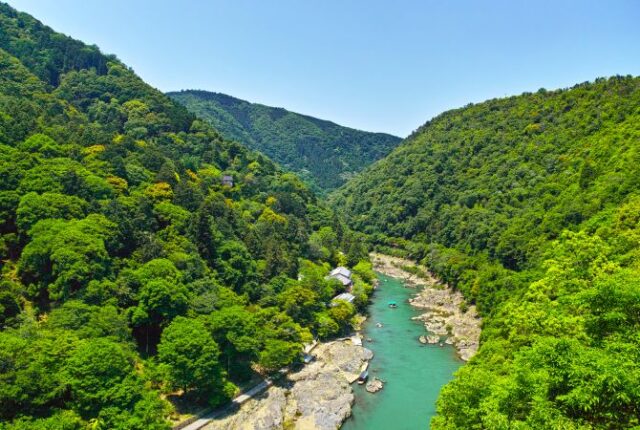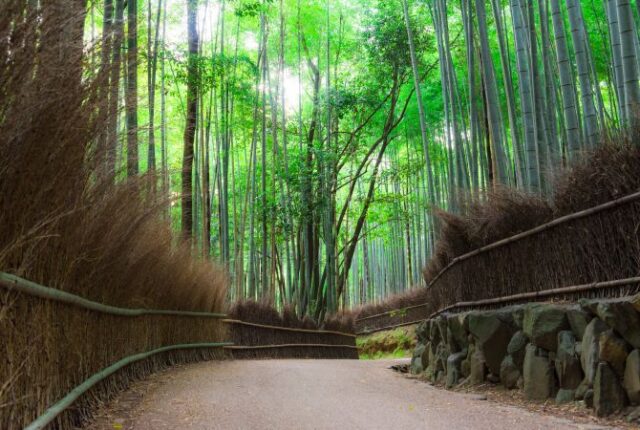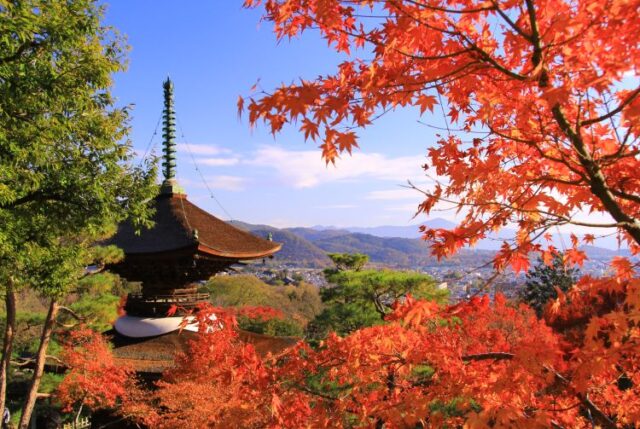The Sagano and Arashiyama districts are located in the western part of Kyoto, and are the city’s second most popular area for sightseeing. In the eighth century, aristocrats often came to this area of rice fields and bamboo woods to enjoy the colored leaves or to go boating.
The landscape today is still reminiscent of that period, and you can still visit a number of former villas connected with the nobility, which now serve as small temples.
Don’t Miss
• Tenryuji Temple, now a World Cultural Heritage site
• Togetsukyo Bridge, which looks as it did in the 17th century
• Bamboo grove leading into Sagano

How to Get There
Arashiyama is a distict on the western outskirts of Kyoto. It is easily accessible from both Kyoto and Osaka.
Arashiyama can be reached on one of three railway lines: the JR Sagano Line which serves Saga Arashiyama Station; the Hankyu Line to Arashiyama Station; or the Keifuku Line, with its own Arashiyama Station.
Quick Facts
The area south of the Hozu River is known as Arashiyama; to the north is Sagano
Sagano extends to the picturesque hamlet of Kiyotaki at the base of sacred Mt. Atago
A number of shops in the area specialize in crafts made of bamboo grown in the famous bamboo grove
Arashiyama’s great Zen heart
The largest, most renowned, and greatest temple in the Sagano and Arashiyama area is Tenryuji Temple. It was erected in the 14th century by the then shogun, Ashikaga Takauji, in a gesture of mourning for the tragic Emperor Godaigo.
Now, Tenryuji is a World Cultural Heritage Site and it is one of the Kyoto-gozan (Five Major Temples of Kyoto). Even its garden is designated as a special national scenic spot.
The spirit of Zen permeates all of Tenryuji and serves as a perfect introduction to the whole of Arashiyama.


A harmonious blend of water and culture
Togetsukyo Bridge spans the Hozu River at the foot of Mt. Arashiyama. It is 250 meters long and still retains its 17th century appearance, despite more recent renovations made using steel.
On a summer evening in August, people write their wishes on ‘toro’ lanterns and let them float away on the Hozu River. This beautiful sight is called “Manto-Nagashi,” or the floating of ten-thousand lanterns.


Shady bamboo grove
The Arashiyama Bamboo Grove leading into Sagano has long been the subject of travel posters, and for many people around the world it represents one of the many faces of Kyoto. A forest of nothing but towering bamboo of uniform height, it truly is a breathtaking sight.


A temple town full of treasures
The Sagano area proper has a large number of temples. They include Daikakuji Temple (a national treasure), Jojakkoji Temple with its Tahoto Tower, Nisonin Temple with a standing statue of Buddha Shaka-nyorai and a statue of Buddha Amida-nyorai, Jikishian with a standing statue of Buddha Shaka-nyorai (a national treasure), Seiryoji Temple with a statue of Buddha Shaka-nyorai (a national treasure), and the Adashino Nenbutsuji Temple , famous for the Sento-Kuyo, or the Thousand Lantern Memorial Service, held there every August.

Sake, crickets, and moss
The area of Rakusei , south of Togetsukyo Bridge is a good place to escape the crowds. A short walk from the bridge brings the visitor to Matsunoo Taisha , a shrine to the god of sake brewing which attracts many worshippers.
Not far along, Kegonji, or Suzumushidera Temple , is known for its suzumushi, or bell crickets, that chirp all year round. Saihoji Temple next door is famous for its moss garden, resplendent with 120 types of beautiful moss.

Japan’s most precious imperial villa
Rakusei’s main attraction is certainly Katsura Imperial Villa , a world-famous imperial villa featuring a simple but functional architectural style. Several teahouses dot the grounds, interconnected by a foot path that winds through what many consider to be Japan’s most beautiful garden. You can take a guided tour around the grounds.


The Sagano and Arashiyama area is vast, but it can be navigated in a well organized walking tour. A comprehensive tour takes around four or five hours.

